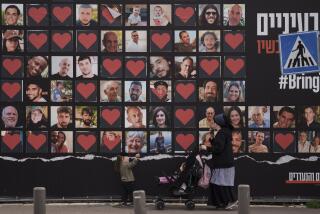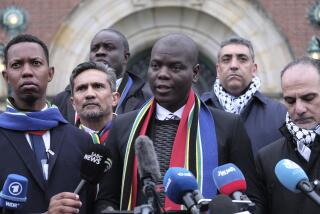COLUMN ONE : A Tribunal in a Time of Atrocities : Accusers call Dusan Tadic a free-lance thug in the Balkans. He may be small fry, but case could pave way for a permanent war-crimes court.
THE HAGUE — Dressed in jeans, white T-shirt and a navy blazer, seated behind the bulletproof glass of the defendant’s dock, Dusan Tadic does not seem up to the role in which he has been cast: prime scapegoat for the oceans of blood that have been shed in the former Yugoslav federation.
His face, pale and puffy after months in isolation, gives little away as he listens to the proceedings of the first international war-crimes tribunal in half a century--pretrial hearings that could one day be the foundation of a permanent international court. Yet Tadic’s rap sheet is not for the faint of heart.
He is accused of having frequented the Serb-run Omarska concentration camp in northwestern Bosnia-Herzegovina in 1992--a lockup that became notorious that August when journalists arrived and beamed home shocking images of the half-starved inmates, trapped behind barbed wire, looking much like the innocents imprisoned by the Nazis.
According to witnesses, Tadic beat prisoners to death, raped at least one woman, forced people to crawl like pigs and drink mud from puddles, ordered others to drink motor oil from a sump pit and--in the most infamous allegation--ordered one prisoner to castrate another with his teeth.
In a crowning touch of sadistic creativity, Tadic--who reportedly favored military clothing and a black mask during these outrages--is accused of having blasted a fire extinguisher into the mouth of a half-dead victim.
Assault and battery, rape and murder--these are what such acts would be called if Tadic was tried in an ordinary court. But the International Criminal Tribunal for the Former Yugoslavia is not an ordinary court, and it hopes to make something more of his case.
The prosecution calls Tadic’s alleged crimes “a clear illustration of a plan” for the systematic destruction of non-Serbian populations in much of Bosnia.
And the tribunal’s work marks the first attempt since the defeat of the Third Reich not only to declare such wartime behavior intolerable but also to punish erring belligerents, from private to president.
Dutch authorities will not let journalists meet with the 39-year-old Tadic. But through his lawyers, he has denied the charges against him. His team of defense lawyers has been arguing this summer that the U.N. Security Council exceeded its authority in setting up an ad hoc international court to try him and others like him.
Even without such challenges to its jurisdiction, the 2-year-old tribunal will be fighting long odds in trying to bring the war criminals of the Balkans to book. It is short on funds; it lacks its own complement of arresting officers; it is powerless to conduct trials in absentia, and the lawyers and judges on its international staff come from a range of incompatible legal traditions.
Worse yet, the tribunal has been denounced by Serbs, who note that it has so far indicted only their kind and not a single Bosnian Muslim or Croat in the Balkan conflict.
But for all this, the hope remains that the tribunal, housed in the refitted, Art Deco former headquarters of a Dutch insurance company, will not only grind out Tadic’s conviction but also help point the way back to sanity and justice in a land of maimed children and bombarded refugee columns, of serial outrage and counter-outrage that the world seems powerless to stop.
Beyond that, well-wishers say, the ad hoc tribunal could conceivably set precedent for the creation of a permanent international war-crimes court--a standing body to investigate and prosecute the sort of atrocities that have gone unpunished over the years in Cambodia, East Timor, Guatemala and other locales along the world’s death-and-revolution belt.
Already, a parallel U.N. tribunal is investigating possible indictments for war crimes in Rwanda, where more than half a million people--most members of the minority Tutsi group--are believed to have been murdered last year in fighting with rival Hutus.
And the U.N. General Assembly expects to convene a conference next spring at which the so-called international community may finally agree--after years of failure--on the creation of a permanent world court for war crimes.
“It’s a high-risk thing,” says Dan Derby, a professor at Touro Law School in Huntington, N.Y., and a longtime activist in the movement to create such a permanent court. “If this tribunal [in The Hague] comes out looking silly--or, worse yet, unjust--it could set back the whole idea of an international court for decades.
“But,” Derby adds, “if it can handle just a handful of cases relatively well, then it could provide some lessons on how to create a permanent court in the future.”
As it happens, Tadic is only one of 46 alleged war criminals who have been indicted by the tribunal so far. And despite the spectacular nature of his alleged crimes, he is but a bit player among the lot. Tadic wasn’t even an official guard at Omarska; witnesses describe him as a kind of free-lance thug, a former martial-arts instructor whose taste for violence was exploited by those in charge at the prison.
Others indicted but still at large include higher-ranking members of the Serbian command: prison camp guards and commanders, leaders of paramilitary squads and territorial-defense units, local politicos, a police chief and--at the top of the power chain--the leaders of the rebel Serbs in Bosnia and Croatia, Radovan Karadzic and Milan Martic. Also charged is the Bosnian Serb army commander, Gen. Ratko Mladic.
So far, all have evaded apprehension by staying in Serb-held territory, out of reach of, say, Interpol, the international police organization.
“It’s very difficult, from a prosecutor’s point of view,” admits Richard Goldstone, a respected South African jurist who is the tribunal’s lead prosecutor. “In Nuremberg”--where an international tribunal tried such Nazi leaders as Hermann Goering and Albert Speer in 1945 and 1946--”the prosecutors had complete control. They could get their hands on any documents and witnesses they wanted.”
The Nuremberg prosecutors even convicted one Nazi, Martin Bormann, in absentia. (Bormann, a personal secretary to Adolf Hitler, was already dead at the time, but the tribunal didn’t know it.)
In The Hague, by contrast, Goldstone and his staff work with nothing like the vast paper trail the Nazis left behind. They lack the practical means to send investigators into the killing fields of Bosnia and Croatia and must make do with the conflicting reports of often-traumatized “witnesses” from the concentration camps.
And for a defendant, they have only Tadic, by most accounts a man of modest intelligence, a volatile temper and no remarkable commitment to the Serbian nationalist cause.
Much of the original case against Tadic was put together in Germany, which, since the war began, has taken in at least 350,000 asylum-seekers from the former Yugoslav federation. A driving force behind his arrest was Husein Besic, a Muslim building contractor born in the Yugoslav federation. He came to Germany as a guest worker years before the Bosnian conflict started and runs a construction company in Hamburg.
Besic believes Tadic killed his brother-in-law, Jasmin Hrnic, at the Omarska camp. Since 1992, Besic has taken care of his widowed sister and her young son.
“Until the end of my life, I will follow these war criminals and see to it that they get what they deserve,” says Besic, who adds that he is inspired by Nazi hunter Simon Wiesenthal. “That means they must be sentenced in a public court.”
With the help of other Bosnian emigres in Hamburg, Besic interviewed Omarska survivors, trying to piece together a record of what had happened.
“We grew up together,” he says of Tadic. “He was my neighbor. His house was only 100 meters from my house. As a child, he was always odd, picking fights and beating up on other children.”
Tadic grew up to be a failed art student, a martial-arts instructor and owner of a family cafe in the northwestern Bosnian town of Kozarac. Although hot-tempered, he was never much interested in Serbian politics, Besic says. That interest came only in 1992, when some of his creditors--Muslims, by chance--called in the loans on his house.
Suddenly, Tadic became a Serbian militant, Besic says, banning Muslims from his cafe and joining the nationalist Serbian Democratic Party.
All of this coincided with the political unrest stemming from Bosnia’s self-declared independence from the Yugoslav federation in March, 1992.
By April of that year, all-out fighting had spread across Bosnia, and it turned out that the region around Kozarac had strategic importance for the Serbian forces, lying as it did on a potential weapons-transport corridor between the rump Yugoslavia and the much-contested Krajina border region between Bosnia and Croatia.
The Serbs’ longing to control this territory helps explain what happened next: Kozarac and its environs fell to the Serbs; its longtime Muslim and Croatian residents were brutally run out. Their property was seized, their houses burned down. Some were done away with on the spot, while others were packed off to detention camps, including Omarska.
In 1991, 50,000 Muslims had been living in the area, investigators estimate; by 1993, more than 43,000 had been killed or driven into exile.
“They killed all the wealthy, educated people first,” Besic contends. “Doctors, well-known people, mayors, police officers--anyone who was able to organize anything. Later, when these people were finished off, they started killing indiscriminately.”
It is this clear pattern of murdering the non-Serbian elite, investigators say, that makes the Kozarac killings fit the broader pattern of genocide.
Tadic has said, through lawyers, that he had already fled Kozarac by the time the Serb-led roundups started. And he left Bosnia altogether in 1993 for fear of being drafted into the Bosnian Serb army--something his lawyers have underscored as evidence of his lack of interest in fighting non-Serbs.
Tadic might be a free man today if he hadn’t decided to make a new home in Germany, with its huge population of Bosnian refugees. It wasn’t long before one of his enemies recognized him in line at a registration center for foreigners.
Word flew back to Besic that the man who allegedly made his sister a widow was in Germany. With the help of a sympathetic German lawyer, Besic and his circle took a complaint to German police.
One day, when Tadic was out walking, the police tackled, arrested and jailed him.
“We could have nabbed Tadic ourselves,” Besic says. “We could have killed him. But then he would have become a martyr, and that is not our aim. Our aim is to make sure that the whole world knows about what is happening in Bosnia. A dead war criminal cannot bear witness.”
While this drama was unfolding in Germany, those television images of the near-skeletal inmates at Omarska were having an effect few other atrocity reports have had in the past half a century: They were prompting the world to “do something.”
Rights activists have been trying since the 1950s to create a mechanism to enforce international war-crimes conventions, but their work had been bogged down in Cold War posturing and highly politicized debates about defining such concepts as “aggression.”
“The Cold War was clearly a major impediment” to prosecuting war crimes, Derby says. “Half the world was saying that the use of napalm was a war crime in the 1960s, but Henry Kissinger wasn’t going to support the prosecution of war crimes at a time when the United States was using napalm.
“The Bosnia situation was the straw that broke the camel’s back,” Derby says. The sight of educated white Europeans behind barbed wire provoked a world that had come to expect, if not accept, such images from backwaters populated by the poor and the nonwhite.
In 1992, the United Nations was able to agree on the impaneling of a Commission of Experts to study the events of that spring and summer near Kozarac. By February, 1993, the commission had produced a report concluding that the Serbian onslaught had incontrovertibly involved crimes against humanity--some of them possibly satisfying the legal definition of genocide.
That same month, the U.N. Security Council established the International Criminal Tribunal for the Former Yugoslavia. After more than a year of U.N.-style argument and delay, Goldstone was appointed its lead prosecutor in July, 1994.
Goldstone is, as it happens, the deceptively quiet, strong-willed jurist who led a pivotal investigation of violence in the South African townships. He changed the course of history by revealing that the police had secretly tried to sabotage South Africa’s transition to democracy. His arrival in The Hague gave much-needed impetus to what had until then looked like just another doomed U.N. gesture.
In February, the tribunal indicted Tadic, and in April, Germany extradited him to The Hague.
Today, Tadic spends his days in a Dutch prison, in the silence of a special jail-within-a-jail created for war-crimes defendants. With his Dutch and Serbian lawyers challenging the validity of the case against him on a number of grounds, there is no chance of a trial until at least the fall.
Even the tribunal’s well-wishers worry that in trying Tadic it is directing too much of its meager resources to a small fry.
But Goldstone argues that by calling witnesses in the Tadic trial, he can create a body of evidence that will strengthen his cases against Karadzic, Mladic and Martic.
Not that they can be tried in absentia. But the tribunal is empowered to hold public hearings to evaluate the evidence against the rebel Serb leaders. These would be expected to make it clear to the world that the leadership consists, officially, of international outlaws--not to be negotiated with, not to be granted amnesty in a future peace deal, but to be arrested any time they venture outside their own turf.
Such a state of affairs might, in turn, conceivably give pause to a politician or general in some other blood-soaked country who may be tempted to mount a siege, order the bombardment of civilians, scatter land mines at random or commit other violations of the conventions of war.
“We have to bring home that there is some [wartime] conduct which is beyond the pale,” Goldstone said. “It may sound like an oxymoron, but we are seeking to make judgments about what constitutes admissible war conduct.”
More to Read
Sign up for Essential California
The most important California stories and recommendations in your inbox every morning.
You may occasionally receive promotional content from the Los Angeles Times.










